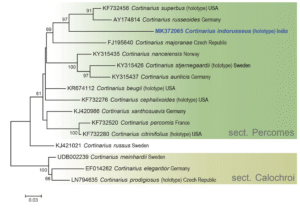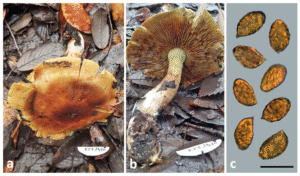Cortinarius indorusseus Dima, Semwal, V.K. Bhatt & Brandrud, sp. nov.
Index Fungorum number: IF 829293; MycoBank number: MB 829293; Facesoffungi number: FoF 05731; Fig. 76
Etymology: Refers to the similarity to C. mussivus (= C. russeus)–C. russeoides complex in sect. Percomes.
Holotype: KCS2470.
Pileus up to 110 mm diam, plano-convex to applanate, with a faint umbo at centre, surface glabrous, glutinous, light greenish yellow at margin, cinnamon brown to light orange brown (6D6–5A4) towards centre, which oxidizes to reddish brown when mature; margin rimose with age, cuticle half peeling. Lamellae adnate, crowded, up to 7 mm broad, lamellulae of various lengths present, wax yellow when young later becoming more brownish orange (5A5–5C5). Stipe 120 × 18 mm, central, subcylindrical, slightly clavate at base, widening at apex, pastel yellow to greenish yellow (3A4) above cortina, paler downwards, (6D5); basal mycelium mainly whitish, mycelial strands at base yellow; universal veil forming a thin girdle/zone halfway up the stipe, brownish to faintly vinaceous brown (5D8–5D6). Context greenish yellow to yellowish, KOH reaction not observed. Odour distinctly earth-like. Taste not observed. Basidiospores: 9.5–10.5 × 5.5–6.5 µm, MV = 9.9 × 5.9 µm, Q = 1.6–1.8, Qav = 1.67 (n = 40), amygdaloid, strongly verrucose. Spore print rusty brown. Pileipellis simplex, thick. Habitat and distribution: Solitary, occurring in leaf litter on humid soil, in temperate broadleaved forests dominated mainly by Quercus leucotrichophora A. Camus, Myrica esculenta Buch. Ham. ex. D. Don, and Rhododendron arboreum Sm.
Material examined: INDIA, Uttarakhand, Pauri Garhwal, Phedhkhal, 1950 m asl, 17 August 2015, K.C. Semwal, KCS 2470 (CAL, holotype).
GenBank numbers: ITS: MK372065.
Notes: Cortinarius indorusseus is a typical member of sect. Percomes characterized by the glutinous, (greenish) yellow pileus surface that oxidizes to reddish brown with age, especially at the centre, the slender, clavate stipe, the yellowish context, the earth odour and the amygdaloid, strongly verrucose spores. Phylogenetically, C. indorusseus is very distinct from all member of sect. Percomes with a difference of more than 70 substitution and indel positions from the closest relative C. russeoides. Within the section, C. indorusseus forms a subclade with the European C. russeoides and the North American C. superbus (Fig. 75). Macromorphologically it resembles very much C. russeoides and C. mussivus (= C. russeus) associated with European conifers (Jeppesen et al. 2012). However, C. indorusseus differs from these and all other macroscopically similar species in sect. Percomes in possessing significantly smaller spores (< 10 × 6 µm). Furthermore, the habitat is special; occurring in forests with the evergreen Quercus leucotrichophora (Banjh oak) and Rhododendron arboretum in north-western Himalaya, India. In the Mediterranean region, C. aurilicis is frequent in a similar habitat with Quercus ilex. However, this species differs in the more strongly red-brown to orange pileus colour and the slightly marginate bulb, where the universal veil remnants remain attached at the base of the stipe. This feature also distinguishes this species from those found in other broad-leaved forests, such as C. nanceiensis associated with Fagus and Tilia in south-eastern Europe.

Fig. 75 Phylogenetic position of Cortinarius indorusseus (KCS 2470, holotype) within sect. Percomes inferred from the ITS sequences. Bootstrap support values (ML) ≥ 50% are given near nodes. The tree is rooted with members of sect. Calochroi. The new species is in blue

Fig. 76 Basidiocarp and spores of Cortinarius indorusseus (KCS 2470, holotype). a–b Basidiocarp. c Spores. Scale bar: c = 10 µm
